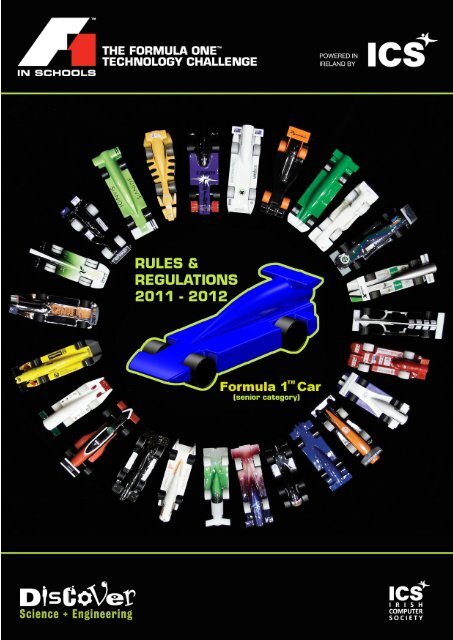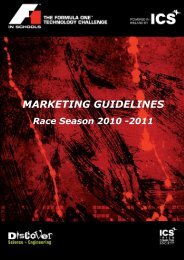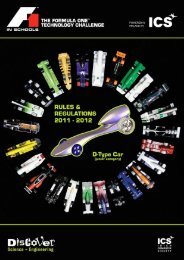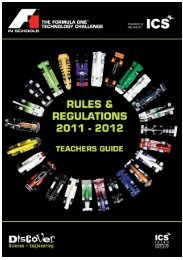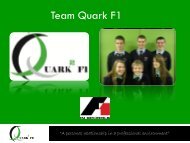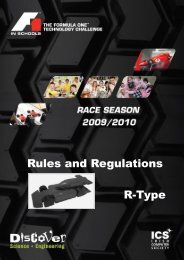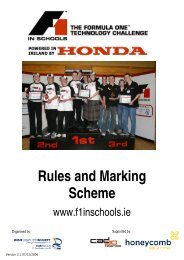Download the F1 in Schools Rules and Regulations Formula One Car
Download the F1 in Schools Rules and Regulations Formula One Car
Download the F1 in Schools Rules and Regulations Formula One Car
You also want an ePaper? Increase the reach of your titles
YUMPU automatically turns print PDFs into web optimized ePapers that Google loves.
WHAT IS THE <strong>F1</strong> IN SCHOOLS CHALLENGE?<br />
The <strong>F1</strong> <strong>in</strong> <strong>Schools</strong> is a global multi-discipl<strong>in</strong>ary competition, that challenges secondary school students <strong>in</strong> <strong>the</strong><br />
Republic of Irel<strong>and</strong>, to design, build <strong>and</strong> race m<strong>in</strong>iature compressed air-powered balsa wood <strong>Formula</strong> <strong>One</strong> cars.<br />
Student teams will compete aga<strong>in</strong>st each o<strong>the</strong>r <strong>in</strong> <strong>the</strong> National F<strong>in</strong>al to determ<strong>in</strong>e <strong>the</strong> best eng<strong>in</strong>eered <strong>and</strong> fastest<br />
car <strong>in</strong> Irel<strong>and</strong>.<br />
Design will play a critical role <strong>in</strong> <strong>the</strong> success of your team - both <strong>in</strong> <strong>the</strong> design of <strong>the</strong> car itself <strong>and</strong> <strong>the</strong> people <strong>in</strong>volved<br />
<strong>in</strong> br<strong>in</strong>g<strong>in</strong>g that design from <strong>the</strong> <strong>in</strong>itial idea right through to <strong>the</strong> start<strong>in</strong>g grid. Team members must be<br />
carefully chosen <strong>and</strong> tra<strong>in</strong>ed to work toge<strong>the</strong>r, us<strong>in</strong>g cutt<strong>in</strong>g edge design software <strong>and</strong> <strong>the</strong> latest <strong>in</strong> manufactur<strong>in</strong>g<br />
technology.<br />
Students are encouraged to use software tools to manage <strong>the</strong>ir projects <strong>and</strong> to develop a<br />
project website to communicate how <strong>the</strong>ir designs evolved.<br />
Left: National Champions 2011 Team<br />
Octane Rac<strong>in</strong>g, Dundalk<br />
Grammar School.<br />
Right: National Championship<br />
w<strong>in</strong>n<strong>in</strong>g car 2011<br />
Students are encouraged to use software tools to manage <strong>the</strong>ir projects <strong>and</strong> to develop a project website to<br />
communicate how <strong>the</strong>ir designs evolved.<br />
The 2010/11 Challenge was a great success with 90 teams compet<strong>in</strong>g head to head on <strong>the</strong> track at Regional F<strong>in</strong>als.<br />
All Regional F<strong>in</strong>als for <strong>the</strong> 2011/12 season will be held <strong>in</strong> March. The National F<strong>in</strong>als will be held on 26th April 2012.<br />
The Challenge is part of an <strong>in</strong>ternational competition which <strong>in</strong> September 2011 saw 23 teams from around <strong>the</strong><br />
world compete for <strong>the</strong> crown.<br />
The <strong>F1</strong> <strong>in</strong> <strong>Schools</strong> Challenge is managed by <strong>the</strong> Irish Computer Society <strong>and</strong> ICS Skills <strong>in</strong> partnership with Discover<br />
Science <strong>and</strong> Eng<strong>in</strong>eer<strong>in</strong>g. <strong>F1</strong> <strong>in</strong> <strong>Schools</strong> is operated on a not-for-profit basis by ICS Skills, a registered charity.<br />
<strong>F1</strong> <strong>in</strong> <strong>Schools</strong> Technology Challenge Revision 1.2 2
THE DESIGN BRIEF<br />
You are <strong>the</strong> <strong>Formula</strong> <strong>One</strong> Team commissioned to design, construct <strong>and</strong> race <strong>the</strong> fastest <strong>Formula</strong> <strong>One</strong> <strong>Car</strong> of<br />
<strong>the</strong> Future, driven by compact compressed air powerplants (cartridges). The particular design specifications <strong>and</strong><br />
rac<strong>in</strong>g regulations for this controlled rac<strong>in</strong>g are outl<strong>in</strong>ed <strong>in</strong> this document.<br />
To succeed <strong>in</strong> <strong>the</strong> challenge you will need to work with modern design technologies like 3D CAD software. In order<br />
to enter <strong>the</strong> Championship, you must allocate job roles to <strong>the</strong> members of your group. Ideally, one role<br />
should be allocated to each person. However, you may have to double up on your role <strong>and</strong> responsibilities, depend<strong>in</strong>g<br />
on <strong>the</strong> number of people you have available.<br />
The follow<strong>in</strong>g job roles should be covered by <strong>the</strong> members of your team:<br />
Team Manager (maximum 1 person). This person will be responsible for manag<strong>in</strong>g <strong>the</strong> team,<br />
ensur<strong>in</strong>g that <strong>the</strong> car is ready for <strong>the</strong> f<strong>in</strong>als. The team manager works closely with all members<br />
of <strong>the</strong> team, offer<strong>in</strong>g assistance where necessary.<br />
Resources Manager (maximum 1 person). This person organises time, materials <strong>and</strong> equipment<br />
for design <strong>and</strong> mak<strong>in</strong>g <strong>the</strong> cars. The resources manager will need to liaise with all members to<br />
check tasks are progress<strong>in</strong>g on time <strong>and</strong> offer additional help, if needed.<br />
Manufactur<strong>in</strong>g Eng<strong>in</strong>eer (maximum 2 persons). These people are responsible for advis<strong>in</strong>g team<br />
members on <strong>the</strong> manufacture of <strong>the</strong> car <strong>and</strong> <strong>the</strong> constra<strong>in</strong>ts of <strong>the</strong> mach<strong>in</strong><strong>in</strong>g process. Manufactur<strong>in</strong>g<br />
eng<strong>in</strong>eers will need to liaise with <strong>the</strong> design eng<strong>in</strong>eers to report <strong>and</strong> help solve any problems<br />
with construction of <strong>the</strong> car.<br />
Design Eng<strong>in</strong>eer (maximum 2 persons). These people are responsible for <strong>the</strong> styl<strong>in</strong>g <strong>and</strong> aerodynamic<br />
performance of <strong>the</strong> car design. Design eng<strong>in</strong>eers will need to liaise with <strong>the</strong> manufactur<strong>in</strong>g<br />
eng<strong>in</strong>eers to ensure <strong>the</strong>ir ideas can be realised.<br />
Graphic Designer (maximum 1 person). This person will be responsible for produc<strong>in</strong>g <strong>the</strong> colour<br />
schemes applied to <strong>the</strong> vehicle, <strong>in</strong>clud<strong>in</strong>g any special sponsorship decals, toge<strong>the</strong>r with <strong>the</strong> f<strong>in</strong>al<br />
graphic render<strong>in</strong>gs <strong>and</strong> any additional team market<strong>in</strong>g materials. The graphic designer will need<br />
to liaise with <strong>the</strong> design eng<strong>in</strong>eer to ensure any schemes will fit <strong>the</strong> shape of <strong>the</strong> vehicle <strong>and</strong> <strong>the</strong><br />
market<strong>in</strong>g <strong>and</strong> communications manager for additional market<strong>in</strong>g development.<br />
Market<strong>in</strong>g <strong>and</strong> Communications Manager (maximum 1 person). This person will be responsible<br />
for develop<strong>in</strong>g team market<strong>in</strong>g <strong>and</strong> sponsorship generation. The market<strong>in</strong>g <strong>and</strong> communications<br />
manager will need to liaise with <strong>F1</strong> <strong>in</strong> School’s Market<strong>in</strong>g Team, local media <strong>and</strong> potential<br />
sponsors to ensure maximum coverage for <strong>the</strong>ir team.<br />
There are so many tasks that must be mastered, <strong>in</strong> order to design, manufacture, prepare <strong>and</strong> f<strong>in</strong>ally enter a car<br />
for rac<strong>in</strong>g, that teamwork will be vital to your success. A real <strong>F1</strong> team succeeds because all <strong>the</strong> people learn to<br />
work toge<strong>the</strong>r <strong>and</strong> support each o<strong>the</strong>r.<br />
Remember, no one person is more important than ano<strong>the</strong>r.<br />
<strong>F1</strong> <strong>in</strong> <strong>Schools</strong> Technology Challenge Revision 1.2 3
GENERAL REGULATIONS<br />
Your team must comply with all <strong>the</strong> guidel<strong>in</strong>es outl<strong>in</strong>ed below:<br />
Each team should consist of a m<strong>in</strong>imum of 3 members to a maximum of 6. Mixed gender teams would<br />
be preferred <strong>and</strong> positively encouraged.<br />
Due to <strong>the</strong> <strong>in</strong>creas<strong>in</strong>g numbers enter<strong>in</strong>g <strong>the</strong> competition it has been necessary to <strong>in</strong>troduce a Qualify<strong>in</strong>g<br />
stage. Entry to this Qualify<strong>in</strong>g Stage will be open to all schools <strong>and</strong> entry is free.<br />
Each school can enter as many teams as <strong>the</strong>y wish for <strong>the</strong> Qualify<strong>in</strong>g Stage, but a maximum of two teams<br />
from each category (Junior / Senior Cycle) will be allowed to progress through to <strong>the</strong> Regional F<strong>in</strong>als.<br />
All teams must submit a five page plan for <strong>the</strong> Qualify<strong>in</strong>g Stage by 18th November 2011. Registration of<br />
schools/teams is onl<strong>in</strong>e at www.<strong>F1</strong><strong>in</strong><strong>Schools</strong>.ie<br />
The Qualify<strong>in</strong>g Stage will be judged follow<strong>in</strong>g <strong>the</strong> submission of a 5 page plan. The details for this Stage<br />
follow <strong>in</strong> this document under <strong>the</strong> Qualify<strong>in</strong>g Stage head<strong>in</strong>g on pages 7 <strong>and</strong> 8.<br />
Teams’ 5 page plans are judged to select approximately 100 teams to progress to Manufactur<strong>in</strong>g <strong>and</strong><br />
Regional F<strong>in</strong>al stage. The teams that score highest <strong>in</strong> <strong>the</strong> Qualify<strong>in</strong>g Stage will proceed through to <strong>the</strong><br />
Regional F<strong>in</strong>als. All schools will be notified by email if <strong>the</strong>y have/have not succeeded <strong>in</strong> progress<strong>in</strong>g<br />
through to <strong>the</strong> Regional F<strong>in</strong>al stage. There is a fee of €80 per team for those who qualify for <strong>the</strong> Regional<br />
F<strong>in</strong>al stage.<br />
Senior Cycle teams must design <strong>the</strong> <strong>Formula</strong> <strong>One</strong> car. Junior Cycle teams must design <strong>the</strong> D-Type car. For<br />
details on Competition Categories view page 9 of this document.<br />
Your team must use 3D CAD (Computer Aided Design) software to produce your ideas <strong>and</strong> model <strong>the</strong>m <strong>in</strong><br />
3D. Details on how to obta<strong>in</strong> your free copy of Solid Works software from <strong>F1</strong> <strong>in</strong> <strong>Schools</strong>, is available on <strong>the</strong><br />
website (www.f1<strong>in</strong>schools.ie).<br />
The dimensions of your car body, toge<strong>the</strong>r with <strong>the</strong> wheels, must fit <strong>the</strong> dimensions outl<strong>in</strong>ed <strong>in</strong> <strong>the</strong> rules.<br />
Po<strong>in</strong>ts will be deducted o<strong>the</strong>rwise. Please check <strong>the</strong>se very carefully. Please note <strong>the</strong>re are critical<br />
technical regulations that must be achieved, fur<strong>the</strong>r details on page 12 of this document.<br />
The car body must be mach<strong>in</strong>ed from a s<strong>in</strong>gle piece of balsa wood. The front aerofoil <strong>and</strong> rear aerofoil may<br />
be mach<strong>in</strong>ed from a separate non-metallic material e.g. ABS. This applies also to support<strong>in</strong>g structures.<br />
Each car body must be manufactured ei<strong>the</strong>r at your school or at a designated Manufactur<strong>in</strong>g Centre, which<br />
<strong>F1</strong> <strong>in</strong> <strong>Schools</strong> will pair your team with. Your <strong>F1</strong> car must be manufactured on a CNC mach<strong>in</strong>e, such as a<br />
Denford MicroRouter, ei<strong>the</strong>r at your school or at an <strong>F1</strong> <strong>in</strong> <strong>Schools</strong> approved Manufactur<strong>in</strong>g Centre.<br />
Each car body must be completed with a high quality pa<strong>in</strong>ted f<strong>in</strong>ish. Note that only a limited amount of<br />
h<strong>and</strong> f<strong>in</strong>ish<strong>in</strong>g to <strong>the</strong> body is allowed. Only one car is required at regional <strong>and</strong> national f<strong>in</strong>al level.<br />
At Regional <strong>and</strong> National F<strong>in</strong>al stages each team must produce a design portfolio which details <strong>the</strong> design,<br />
production <strong>and</strong> evaluation process <strong>in</strong>clud<strong>in</strong>g, <strong>in</strong>itial ideas, design development, manufacture <strong>and</strong> evidence<br />
of test<strong>in</strong>g <strong>and</strong> evaluation. Max 20 pages (A3).<br />
At Regional <strong>and</strong> National F<strong>in</strong>al stages each team must supply a 1 st or 3 rd angle orthographic projection <strong>and</strong><br />
a graphic render<strong>in</strong>g of <strong>the</strong>ir f<strong>in</strong>al design, both produced us<strong>in</strong>g a 3D CAD package.<br />
At Regional <strong>and</strong> National F<strong>in</strong>al stages each team must complete a specification sheet, which must be<br />
displayed at each race event. This specification sheet should be completed before arriv<strong>in</strong>g at <strong>the</strong> race<br />
event.<br />
At Regional <strong>and</strong> National F<strong>in</strong>al stages teams must prepare a verbal presentation on <strong>the</strong>ir work. 5 m<strong>in</strong>utes<br />
will be allocated to present to <strong>the</strong> judges.<br />
These rules are based on <strong>the</strong> <strong>F1</strong> <strong>in</strong> <strong>Schools</strong> 2011 World F<strong>in</strong>als Technical <strong>Regulations</strong>.<br />
<strong>F1</strong> <strong>in</strong> <strong>Schools</strong> Technology Challenge Revision 1.2 4
DESIGN CONSIDERATIONS<br />
Design Preparation:<br />
Before beg<strong>in</strong>n<strong>in</strong>g to design your car, you will need:<br />
Solid Works or a similar 3D CAD software package at your school/college.<br />
A design template suitable for <strong>the</strong> balsa wood blank. (this can be downloaded at www.<strong>F1</strong><strong>in</strong><strong>Schools</strong>.ie/<br />
resources)<br />
Hopefully, an endless supply of ideas!<br />
Tra<strong>in</strong><strong>in</strong>g:<br />
CAD packages will help you draw <strong>and</strong> develop your ideas <strong>in</strong> 3D. Of course, as with most draw<strong>in</strong>g packages, it<br />
takes time to learn how to use <strong>the</strong>m. Your technology teacher should be able to show you how <strong>the</strong> software<br />
works, but members of your team will need to spend some time explor<strong>in</strong>g <strong>the</strong> software, so you can see what it<br />
can do <strong>and</strong> how it can help you design your <strong>F1</strong> car.<br />
Research:<br />
Investigate exist<strong>in</strong>g <strong>F1</strong> car designs. Your teacher may be able to help you use <strong>the</strong> <strong>in</strong>ternet to f<strong>in</strong>d out <strong>the</strong> latest<br />
developments occurr<strong>in</strong>g <strong>in</strong> <strong>the</strong> world of <strong>F1</strong> design. Team photos from last year’s Challenge can be found at<br />
www.<strong>F1</strong><strong>in</strong><strong>Schools</strong>.ie <strong>in</strong> <strong>the</strong> Gallery section. Concentrate your research on areas that could help your team, for<br />
example, aerodynamics, car body designs <strong>and</strong> wheel designs, <strong>the</strong>n try to apply <strong>the</strong> pr<strong>in</strong>ciples to your own ideas.<br />
Test<strong>in</strong>g:<br />
Your team may want to consider test<strong>in</strong>g a variety of car designs, or car parts, <strong>in</strong> a virtual w<strong>in</strong>d tunnel or physical<br />
w<strong>in</strong>d <strong>and</strong>/or smoke tunnel, if your Make Centre has access to one, to evaluate <strong>the</strong>ir aerodynamic performance.<br />
If your school has a copy of Solid Works you should also have <strong>in</strong>cluded a copy of COSMOS, Solid Works design<br />
analysis software. COSMOSFlowXpress can be used to quickly analyze <strong>the</strong> Race <strong>Car</strong> Block part which is used <strong>in</strong><br />
<strong>the</strong> Race <strong>Car</strong> Assembly.<br />
COSMOSFloXpress is a fluid dynamics application that calculates how fluid, (air or water) flows through a part or<br />
assembly model. Based on <strong>the</strong> calculated velocity field, you can f<strong>in</strong>d problem areas <strong>in</strong> your design <strong>and</strong> improve<br />
<strong>the</strong>m before you manufacture any parts.<br />
MANUFACTURING CONSIDERATIONS<br />
In <strong>the</strong> <strong>F1</strong> <strong>Car</strong> Kit that each team qualify<strong>in</strong>g for <strong>the</strong> Regional f<strong>in</strong>al stage will receive, is a set of 4 wheels <strong>and</strong> 2 axles,<br />
which is <strong>the</strong> m<strong>in</strong>imum that you need to compete at Regional f<strong>in</strong>al stage. Balsa wood will be sent directly on your<br />
behalf to <strong>the</strong> Make Centre.<br />
Note that your car design template must be 10mm shorter at least at one end, compared to <strong>the</strong> actual balsa<br />
wood block (we have accounted for this <strong>in</strong> <strong>the</strong> <strong>Rules</strong> & <strong>Regulations</strong>, po<strong>in</strong>t 3a). You will not be able to mach<strong>in</strong>e to<br />
<strong>the</strong> extreme ends of <strong>the</strong> balsa wood block, s<strong>in</strong>ce <strong>the</strong>y are sometimes used for attach<strong>in</strong>g <strong>the</strong> CNC mach<strong>in</strong>e jig<br />
fixtures. Damage could occur if <strong>the</strong> cutt<strong>in</strong>g tool hits any of <strong>the</strong>se jig fixtures.<br />
The jig is used to stop <strong>the</strong> balsa wood block mov<strong>in</strong>g whilst be<strong>in</strong>g mach<strong>in</strong>ed. It also allows <strong>the</strong> block to be<br />
accurately repositioned. Please note however that some mach<strong>in</strong>es will require only one cut, o<strong>the</strong>rs may require<br />
two cuts, <strong>the</strong>refore you will need to take this <strong>in</strong>to account when you are design<strong>in</strong>g <strong>the</strong> car.<br />
Manufactur<strong>in</strong>g of cars must occur at an approved <strong>F1</strong> <strong>in</strong> <strong>Schools</strong> Manufactur<strong>in</strong>g Centre (3rd level <strong>in</strong>stitution),<br />
which <strong>F1</strong> <strong>in</strong> <strong>Schools</strong> will pair your team with, or if your school has facilities, <strong>in</strong> your own school.<br />
Once mach<strong>in</strong>ed, you can smooth down <strong>the</strong> balsa wood design <strong>and</strong> f<strong>in</strong>ish with primer <strong>and</strong> pa<strong>in</strong>t. Note that only a<br />
limited amount of h<strong>and</strong> f<strong>in</strong>ish<strong>in</strong>g to <strong>the</strong> body is allowed. Filler should not be used to build up areas of your car.<br />
You can also decorate <strong>the</strong> car body with any sponsorship stickers, advertis<strong>in</strong>g or colour schemes.<br />
<strong>F1</strong> <strong>in</strong> <strong>Schools</strong> Technology Challenge Revision 1.2 5
<strong>F1</strong> <strong>in</strong> <strong>Schools</strong> Technology Challenge Revision 1.2 6
QUALIFYING STAGE<br />
Compulsory Qualify<strong>in</strong>g Stage – The First Step onto <strong>the</strong> Grid!!<br />
You are a <strong>Formula</strong> <strong>One</strong> team who must pitch your plan to build <strong>the</strong> Fastest <strong>Formula</strong> <strong>One</strong> <strong>Car</strong> of <strong>the</strong> Future,<br />
driven by compressed air powerplants.<br />
You must submit a plan which demonstrates why your team should be chosen to get your design constructed<br />
to race.<br />
Your plan should give details of your team members, show some areas of your teams research, display your<br />
<strong>in</strong>itial design ideas <strong>and</strong> show some elements of your portfolio e.g. timel<strong>in</strong>e, br<strong>and</strong><strong>in</strong>g etc… Remember, your<br />
team must show why your plan is <strong>the</strong> best!<br />
Your ideas <strong>and</strong> plan should be orig<strong>in</strong>al, if you want to be chosen, be different!<br />
Plan –maximum 5 pages (A4)<br />
All team plans must be submitted by 5pm 18th November 2011<br />
Plans should be submitted by email to f1@ics.ie or by<br />
post to:<br />
ICS, Crescent Hall, Mount Street Crescent, Dubl<strong>in</strong> 2<br />
Your plan should consist of <strong>the</strong> follow<strong>in</strong>g:<br />
<br />
<br />
<br />
<br />
Introduction (1 page)<br />
Research (1 page)<br />
<br />
A look at <strong>the</strong> different ideas beh<strong>in</strong>d mak<strong>in</strong>g your car <strong>the</strong><br />
fastest.<br />
Design (1-2 pages)<br />
<br />
Pencil sketch will suffice, but 3D CAD more advantageous<br />
Resources plann<strong>in</strong>g (1-2 pages)<br />
<br />
Outl<strong>in</strong>e plan to <strong>in</strong>clude, for example: timel<strong>in</strong>e, budget, market<strong>in</strong>g etc..<br />
Plans should have no more than 5 A4 pages, any plans which exceed <strong>the</strong> maximum of 5 pages will only have <strong>the</strong><br />
first 5 pages looked at. The cover of your document is not counted <strong>in</strong> <strong>the</strong>se 5 pages.<br />
To view sample plans, log on to www.<strong>F1</strong><strong>in</strong><strong>Schools</strong>.ie<br />
W<strong>in</strong>n<strong>in</strong>g teams <strong>in</strong>novate!!<br />
<strong>Formula</strong> <strong>One</strong> is constantly <strong>in</strong>novat<strong>in</strong>g <strong>in</strong> all areas of <strong>the</strong> <strong>Formula</strong> <strong>One</strong> bus<strong>in</strong>ess i.e. design, research,<br />
market<strong>in</strong>g. Has your team a dist<strong>in</strong>ct advantage, if so tell us about it <strong>and</strong> earn your team an additional 10% of your<br />
overall po<strong>in</strong>ts for <strong>the</strong> plan!! For fur<strong>the</strong>r breakdown of po<strong>in</strong>ts for Qualify<strong>in</strong>g Stage, view page 9 of this document.<br />
Submit one additional item that can take <strong>the</strong> form of, for example, one of <strong>the</strong> follow<strong>in</strong>g:<br />
An additional A4 page of text or images<br />
A slide show<br />
A video<br />
A team logo<br />
Maximum duration of digital media 3 m<strong>in</strong>utes.<br />
<strong>F1</strong> <strong>in</strong> <strong>Schools</strong> Technology Challenge Revision 1.2 7
QUALIFYING STAGE<br />
MARKING SCHEME FOR QUALIFYING STAGE<br />
Area Key Features Po<strong>in</strong>ts Awarded<br />
Introduction<br />
<strong>One</strong> page <strong>in</strong>troduction to team, job roles, team mission<br />
Max 10 po<strong>in</strong>ts<br />
Research<br />
<strong>One</strong> page featur<strong>in</strong>g areas researched by <strong>the</strong> team for <strong>the</strong><br />
competition e.g. aerodynamics, wheel design…..<br />
Max 10 po<strong>in</strong>ts<br />
Design<br />
1-2 pages of <strong>in</strong>itial sketches of design/designs. Development of<br />
ideas can be by h<strong>and</strong> or with 3D CAD. Teams should show<br />
development of thoughts <strong>and</strong> ideas through use of research.<br />
Note: Use of ICT/CAD is essential to achieve maximum po<strong>in</strong>ts<br />
Max 40 po<strong>in</strong>ts<br />
Brief<br />
1 – 2 pages where teams outl<strong>in</strong>e what <strong>the</strong>ir plan would be, if <strong>the</strong>y<br />
proceed through to <strong>the</strong> Regional F<strong>in</strong>als. This may <strong>in</strong>clude how<br />
<strong>the</strong>y would allocate <strong>the</strong>ir time, fund <strong>the</strong>ir materials/transport, <strong>and</strong><br />
<strong>the</strong>ir range of activities (e.g. project-management, graphic<br />
design, market<strong>in</strong>g, sponsorship etc.).<br />
Max 40 po<strong>in</strong>ts<br />
Innovation<br />
An additional 10% of <strong>the</strong> teams overall mark for above can be achieved by submitt<strong>in</strong>g one<br />
item to demonstrate your teams <strong>in</strong>novation.<br />
*To achieve <strong>the</strong> highest po<strong>in</strong>ts <strong>in</strong> each category teams should use ICT <strong>and</strong> CAD, where possible.*<br />
Note:<br />
At Regional F<strong>in</strong>al stage po<strong>in</strong>ts may be deducted from team’s scores if significant elements of <strong>in</strong>itial<br />
plans are not achieved. Therefore you should ensure your plans are realistic.<br />
<strong>F1</strong> <strong>in</strong> <strong>Schools</strong> Technology Challenge Revision 1.2 8
Manufactur<strong>in</strong>g Centres<br />
Teams will be paired with a Manufactur<strong>in</strong>g Centre (3 rd level <strong>in</strong>stitution) by<br />
<strong>F1</strong> <strong>in</strong> <strong>Schools</strong>, if you do not have facilities <strong>in</strong> your school.<br />
How to obta<strong>in</strong> software, hardware <strong>and</strong> consumables<br />
To obta<strong>in</strong> your free copy of Solid Works software from <strong>F1</strong> <strong>in</strong> <strong>Schools</strong> visit<br />
<strong>the</strong> website (www.f1<strong>in</strong>schools.ie).<br />
If you would like to purchase any equipment for <strong>the</strong> challenge please contact:<br />
Sureweld Educational Division, Fonthill, Lucan, Co. Dubl<strong>in</strong>. Tel: 01 6266 242<br />
Team Prizes <strong>and</strong> Awards<br />
There will be separate awards for:<br />
The Overall W<strong>in</strong>ner of <strong>the</strong> Challenge<br />
<br />
<br />
<br />
<br />
<br />
<br />
<br />
<br />
The 1st, 2nd <strong>and</strong> 3rd W<strong>in</strong>ners <strong>in</strong> each Category<br />
Fastest <strong>Car</strong><br />
Best Eng<strong>in</strong>eered <strong>Car</strong><br />
Best Use of ICT<br />
Best Team Website<br />
Best Digital Market<strong>in</strong>g<br />
Best Team Market<strong>in</strong>g <strong>and</strong> Sponsorship<br />
Best Newcomer<br />
Note: Awards are at <strong>the</strong><br />
Prizes will be awarded at National F<strong>in</strong>al level. Prize packages to be confirmed.<br />
Each <strong>F1</strong> <strong>in</strong> <strong>Schools</strong> competitor will receive a certificate of participation.<br />
discretion of <strong>the</strong> judges.<br />
JUDGING CATEGORIES<br />
There are four (5) ma<strong>in</strong> judg<strong>in</strong>g categories:<br />
Specification Judg<strong>in</strong>g<br />
Portfolio <strong>and</strong> Display Judg<strong>in</strong>g<br />
Eng<strong>in</strong>eer<strong>in</strong>g Judg<strong>in</strong>g<br />
Verbal Presentation Judg<strong>in</strong>g<br />
Rac<strong>in</strong>g<br />
Judg<strong>in</strong>g score cards<br />
The <strong>F1</strong> <strong>in</strong> <strong>Schools</strong> judg<strong>in</strong>g score cards provide detailed <strong>in</strong>formation <strong>in</strong> relation to what <strong>the</strong> Judges will be look<strong>in</strong>g<br />
for. The key performance <strong>in</strong>dicators are used by <strong>the</strong> judges <strong>in</strong> award<strong>in</strong>g po<strong>in</strong>ts dur<strong>in</strong>g <strong>the</strong> judg<strong>in</strong>g activities.<br />
The 2011/12 judg<strong>in</strong>g score cards can be found once you log<strong>in</strong> to <strong>the</strong> www.f1<strong>in</strong>schools.ie website. READING THE<br />
SCORE CARDS CAREFULLY IS IMPORTANT. THEY PROVIDE CRITICAL INFORMATION FOR TEAMS AS TO WHAT<br />
NEEDS TO BE PRESENTED FOR EACH JUDGING CATEGORY.<br />
<strong>F1</strong> <strong>in</strong> <strong>Schools</strong> Technology Challenge Revision 1.2 9
ARTICLE T1 DEFINITIONS<br />
T1.1 <strong>Car</strong> race time value<br />
A ‘car race time’ value is <strong>the</strong> actual time taken for a <strong>F1</strong> <strong>in</strong> <strong>Schools</strong> car to travel <strong>the</strong> track from start to f<strong>in</strong>ish,<br />
measured from <strong>the</strong> <strong>in</strong>stant <strong>the</strong> launch pod fires to when <strong>the</strong> car breaks <strong>the</strong> f<strong>in</strong>ish l<strong>in</strong>e tim<strong>in</strong>g beam. In <strong>the</strong><br />
case of reaction races, <strong>the</strong> ‘car race time’ value is calculated as <strong>the</strong> ‘total race time’ value displayed on <strong>the</strong><br />
electronic start gate m<strong>in</strong>us <strong>the</strong> ‘reaction time’ value displayed for that race.<br />
T1.2 Total race time value<br />
The ‘total race time’ value is displayed <strong>in</strong> <strong>the</strong> total time field on <strong>the</strong> electronic start gate at <strong>the</strong> conclusion of<br />
every race. This time is <strong>the</strong> sum of <strong>the</strong> ‘car race time’ value <strong>and</strong> any ‘reaction time’ value displayed on <strong>the</strong><br />
electronic start gate. Dur<strong>in</strong>g time trial races where <strong>the</strong> automatic launch mode is used <strong>the</strong>re is a zero reaction<br />
time value.<br />
T1.3 Reaction time value<br />
A ‘reaction time’ value is <strong>the</strong> time recorded from <strong>the</strong> <strong>in</strong>stant <strong>the</strong> five (5) start lights ext<strong>in</strong>guish to <strong>the</strong> <strong>in</strong>stant<br />
<strong>the</strong> start trigger is activated by <strong>the</strong> driver. This value is displayed <strong>in</strong> <strong>the</strong> reaction time field on <strong>the</strong> electronic<br />
start gate.<br />
T1.4 <strong>F1</strong> <strong>in</strong> <strong>Schools</strong> car<br />
An <strong>F1</strong> <strong>in</strong> <strong>Schools</strong> car assembly must only consist of <strong>the</strong> follow<strong>in</strong>g components:<br />
A body—which <strong>in</strong>cludes virtual cargo<br />
A CO2 cyl<strong>in</strong>der chamber<br />
A front w<strong>in</strong>g<br />
A rear w<strong>in</strong>g<br />
W<strong>in</strong>g support structures<br />
Nose Cone<br />
Wheels<br />
Wheel support systems<br />
A te<strong>the</strong>r l<strong>in</strong>e slot<br />
Te<strong>the</strong>r l<strong>in</strong>e guides<br />
Pa<strong>in</strong>t f<strong>in</strong>ish <strong>and</strong> decals<br />
The body <strong>and</strong> side pods must be manufactured from <strong>the</strong> official balsa wood blank. Refer to fur<strong>the</strong>r<br />
regulations regard<strong>in</strong>g <strong>the</strong> design parameters for each of <strong>the</strong> above components.<br />
<strong>F1</strong> <strong>in</strong> <strong>Schools</strong> Technology Challenge Revision 1.2 10
T1.5 Body<br />
The body consists only of balsa wood <strong>and</strong> is manufactured us<strong>in</strong>g one or more CNC mach<strong>in</strong><strong>in</strong>g processes.<br />
The body encompasses a virtual cargo <strong>and</strong> bounds <strong>the</strong> CO2 cyl<strong>in</strong>der chamber <strong>and</strong> te<strong>the</strong>r l<strong>in</strong>e slot. Whilst<br />
<strong>the</strong> balsa wood material may cont<strong>in</strong>ue to <strong>the</strong> very front of <strong>the</strong> car, it is not def<strong>in</strong>ed as body forward of <strong>the</strong><br />
front axle centre l<strong>in</strong>e. For dimensional purposes <strong>the</strong> body also <strong>in</strong>cludes any attached decals <strong>and</strong> surface<br />
f<strong>in</strong>ishes.<br />
T1.6 W<strong>in</strong>g<br />
A w<strong>in</strong>g on an <strong>F1</strong> <strong>in</strong> <strong>Schools</strong> car is an aerodynamic feature that permits airflow around ALL of its surfaces<br />
<strong>in</strong>clud<strong>in</strong>g its features of a lead<strong>in</strong>g <strong>and</strong> trail<strong>in</strong>g edge. A w<strong>in</strong>g is dimensionally def<strong>in</strong>ed by <strong>the</strong> maximum <strong>and</strong><br />
m<strong>in</strong>imum span, chord <strong>and</strong> thickness. The vertical cross-sectional shape of <strong>the</strong> w<strong>in</strong>g, parallel to <strong>the</strong><br />
direction of car travel, is referred to as an aerofoil. The follow<strong>in</strong>g diagram assists with describ<strong>in</strong>g relevant<br />
aerofoil features. .<br />
W<strong>in</strong>g cross-section / aerofoil nomenclature<br />
T1.7 W<strong>in</strong>g support structure<br />
Is a non-metallic feature, o<strong>the</strong>r than w<strong>in</strong>g, car body or nose cone that is jo<strong>in</strong>ed to a w<strong>in</strong>g surface <strong>and</strong> may<br />
jo<strong>in</strong> <strong>the</strong> w<strong>in</strong>g to any o<strong>the</strong>r part of <strong>the</strong> car assembly<br />
T1.8 Nose cone<br />
The nose cone is any non-metallic part of <strong>the</strong> car, o<strong>the</strong>r than wheel, wheel support system, w<strong>in</strong>g or w<strong>in</strong>g<br />
support structure, that exists forward of <strong>the</strong> front axle centre l<strong>in</strong>e. This <strong>in</strong>cludes any balsa wood material<br />
that cont<strong>in</strong>ues forward from <strong>the</strong> body.<br />
T1.9 Wheel support system<br />
Wheel support systems are s<strong>in</strong>gle parts or an assembly of components that connect a wheel to any o<strong>the</strong>r<br />
part of <strong>the</strong> car. These may consist of a comb<strong>in</strong>ation of manufactured or commercial parts. I.e. Bear<strong>in</strong>gs,<br />
bushes <strong>and</strong> axles could be used.<br />
T1.10 Te<strong>the</strong>r l<strong>in</strong>e slot<br />
The te<strong>the</strong>r l<strong>in</strong>e slot is a rectangular prism of clear space that is bounded by car body on three sides of its<br />
length.<br />
<strong>F1</strong> <strong>in</strong> <strong>Schools</strong> Technology Challenge Revision 1.2 11
T1.11 Te<strong>the</strong>r l<strong>in</strong>e guide<br />
A te<strong>the</strong>r l<strong>in</strong>e guide is a key safety component which completely surrounds <strong>the</strong> track te<strong>the</strong>r l<strong>in</strong>e so as to<br />
safely connect <strong>the</strong> car to <strong>the</strong> te<strong>the</strong>r l<strong>in</strong>e dur<strong>in</strong>g races. A te<strong>the</strong>r l<strong>in</strong>e guide can be a component sourced<br />
from a supplier or manufactured wholly or <strong>in</strong> part by <strong>the</strong> team.<br />
T1.12 Vertical reference plane<br />
To assist with describ<strong>in</strong>g dimensions, it is assumed that an <strong>in</strong>visible plane exists two dimensional along<br />
<strong>the</strong> length of <strong>the</strong> CO2 cyl<strong>in</strong>der chamber centre axis <strong>and</strong> perpendicular to <strong>the</strong> track surface. This is<br />
known as <strong>the</strong> vertical reference plane.<br />
T1.13 Po<strong>in</strong>t allocations<br />
Po<strong>in</strong>ts will be awarded to teams across five (5) categories with maximum possible scores as detailed<br />
<strong>in</strong> <strong>the</strong> fol-<br />
low<strong>in</strong>g table:<br />
Specification Judg<strong>in</strong>g<br />
Specifications<br />
120 po<strong>in</strong>ts<br />
Eng<strong>in</strong>eer<strong>in</strong>g Judg<strong>in</strong>g<br />
CAD CAM <strong>and</strong> Analysis<br />
Quality of Manufacture<br />
60 po<strong>in</strong>ts<br />
60 po<strong>in</strong>ts<br />
Portfolio <strong>and</strong> Pit Display Judg<strong>in</strong>g<br />
Portfolio<br />
Pit Display <strong>and</strong> Market<strong>in</strong>g<br />
<strong>F1</strong> <strong>Car</strong> Design Process<br />
90 po<strong>in</strong>ts<br />
60 po<strong>in</strong>ts<br />
60 po<strong>in</strong>ts<br />
Verbal Presentation<br />
Technique<br />
Composition<br />
Subject Matter<br />
60 po<strong>in</strong>ts<br />
60 po<strong>in</strong>ts<br />
60 po<strong>in</strong>ts<br />
Rac<strong>in</strong>g<br />
Time Trials<br />
Reaction Rac<strong>in</strong>g<br />
Knock-Out Rac<strong>in</strong>g<br />
170 po<strong>in</strong>ts<br />
60 po<strong>in</strong>ts<br />
40 po<strong>in</strong>ts<br />
TOTAL 900 po<strong>in</strong>ts<br />
<strong>F1</strong> <strong>in</strong> <strong>Schools</strong> Technology Challenge Revision 1.2 12
ARTICLE T2—GENERAL REGULATIONS<br />
T2.1 The <strong>Formula</strong> <strong>One</strong> car design category is for Senior Cycle student teams only.<br />
T2.2 Contact details for <strong>the</strong> Team Manager should be provided, to enable <strong>F1</strong> <strong>in</strong> <strong>Schools</strong> to liaise with <strong>the</strong>m,<br />
this is completed at time of registration on www.<strong>F1</strong><strong>in</strong><strong>Schools</strong>.ie. All team members’ roles must be<br />
entered onl<strong>in</strong>e before Regional f<strong>in</strong>als.<br />
T2.3 Only a limited amount of filler is permitted. It should not be used to build up areas. Disqualification may<br />
occur where measurement of orig<strong>in</strong>al draw<strong>in</strong>g <strong>and</strong> f<strong>in</strong>al car have significant discrepancies.<br />
T2.4 Teams must show evidence of any media footage or press clipp<strong>in</strong>gs <strong>in</strong> order to be awarded po<strong>in</strong>ts for<br />
such media coverage generated.<br />
T2.5 The official length of <strong>the</strong> track, from start<strong>in</strong>g l<strong>in</strong>e to f<strong>in</strong>ish l<strong>in</strong>e, is 20 metres.<br />
T2.6 The <strong>F1</strong> car body must be mach<strong>in</strong>ed from a s<strong>in</strong>gle piece of balsa wood. The front aerofoil <strong>and</strong> <strong>the</strong> rear<br />
aerofoil may be mach<strong>in</strong>ed from a separate non-metallic material. The design of <strong>the</strong> axle <strong>and</strong> bear<strong>in</strong>g<br />
systems is unrestricted.<br />
T2.7 Teams that have been <strong>in</strong>vited to <strong>the</strong> Regional F<strong>in</strong>als <strong>and</strong> National f<strong>in</strong>al will be required to expla<strong>in</strong> how <strong>the</strong>y<br />
completed <strong>the</strong>ir design process to <strong>the</strong> Judges, <strong>in</strong> <strong>the</strong> form of a verbal presentation, with optional<br />
accompany<strong>in</strong>g visual aids. The presentation must not last longer than 5 m<strong>in</strong>utes. Extra time is provided for<br />
set up <strong>and</strong> Judges questions.<br />
T2.8 Should any teams withdraw or become disqualified from <strong>the</strong> Regional F<strong>in</strong>al stage; reserve teams may be<br />
selected from a previously submitted list. These teams will be <strong>in</strong>formed by post/e-mail/telephone call as<br />
soon as <strong>the</strong> organisers are aware of <strong>the</strong> situation.<br />
T2.9 The cars should be produced <strong>in</strong> <strong>the</strong> same year as <strong>the</strong> f<strong>in</strong>als. The same car design should not be entered<br />
more than once.<br />
T2.10 Each design must leave enough space for an entry number sticker to be applied on each side of <strong>the</strong> car<br />
body. Your number will be given to you at registration <strong>and</strong> must be <strong>in</strong> place before rac<strong>in</strong>g. The size of<br />
<strong>the</strong> sticker will be a maximum of 40mm (length) by 25mm (height).<br />
T2.11 When seek<strong>in</strong>g team sponsorship, please ensure that <strong>the</strong> proposed sponsor of your team does not conflict with<br />
<strong>the</strong> <strong>F1</strong> <strong>in</strong> <strong>Schools</strong> Technology Challenge sponsors. If you are unsure if your potential sponsor will conflict please<br />
contact f1@ics.ie for confirmation<br />
T2.12 Critical technical regulations<br />
T2.12.1 <strong>Regulations</strong> identified as a critical technical regulation <strong>and</strong> listed <strong>in</strong> this article. If a team’s primary<br />
race car is judged as be<strong>in</strong>g NON-COMPLIANT with any critical technical regulation <strong>the</strong>y will be INELIGIBLE<br />
for <strong>the</strong> follow<strong>in</strong>g awards:<br />
<br />
<br />
<br />
World Champions<br />
Fastest <strong>Car</strong><br />
Best Eng<strong>in</strong>eered <strong>Car</strong><br />
T2.12.2 The critical technical regulations are articles:<br />
T3.1 / T3.2 / T3.3 / T3.4 / T3.5 / T3.6 / T4.1 / T4.2 / T4.3 / T6.1 / T7.1 / T8.1 / T8.2 / T8.3 / T8.4 / T10.1 / T10.2 / T10.3 /<br />
T10.4 / T10.5 / T10.6<br />
T2.13 Scrut<strong>in</strong>eer<strong>in</strong>g will be more str<strong>in</strong>gent at <strong>the</strong> National F<strong>in</strong>als. If a car passes <strong>in</strong> <strong>the</strong> Regional event this does not<br />
necessarily mean that it will pass at National F<strong>in</strong>al level. It is <strong>the</strong> team’s responsibility to ensure <strong>the</strong>ir car meets<br />
all regulations.<br />
<strong>F1</strong> <strong>in</strong> <strong>Schools</strong> Technology Challenge Revision 1.2 13
ARTICLE T3. FULLY ASSEMBLED CAR<br />
T3.1 Design, manufacture <strong>and</strong> construction – [Critical regulations]<br />
T3.1.1 Design - All <strong>F1</strong> <strong>in</strong> <strong>Schools</strong> cars must be designed <strong>and</strong> eng<strong>in</strong>eered us<strong>in</strong>g CAD (Computer Aided<br />
Design) <strong>and</strong> CAM (Computer Aided Manufacture) technology. CAD software used should provide for 3D<br />
part modell<strong>in</strong>g, assembly <strong>and</strong> 3D realistic render<strong>in</strong>g.<br />
T3.1.2 Manufacture - The body of all <strong>F1</strong> <strong>in</strong> <strong>Schools</strong> cars must be manufactured via material removal us<strong>in</strong>g a<br />
CNC router/ mill<strong>in</strong>g mach<strong>in</strong>e. This manufactur<strong>in</strong>g process should occur at your school/college or at a<br />
designated manufactur<strong>in</strong>g centre/partner site.<br />
T3.1.3 Limited h<strong>and</strong> f<strong>in</strong>ish<strong>in</strong>g of <strong>the</strong> car body is permitted.<br />
T3.1.4 Pa<strong>in</strong>t f<strong>in</strong>ish - Each car body should feature a high quality pa<strong>in</strong>t f<strong>in</strong>ish.<br />
T3.2 Undef<strong>in</strong>ed features – [Critical regulation │Penalty – 12pts]<br />
The car assembly must only consist of components listed <strong>in</strong> ARTICLE T1.1.<br />
T3.3 Overall length – [Critical regulation │Penalty – 12pts]<br />
This is measured parallel to <strong>the</strong> track surface <strong>and</strong> vertical reference plane, between <strong>the</strong> front <strong>and</strong> rear<br />
extremities of <strong>the</strong> assembled car.<br />
M<strong>in</strong>: 170mm / Max: 210mm<br />
T3.4 Overall<br />
width – [Critical<br />
regulation │Penalty – 12pts]<br />
Total assembled car width, measured normal to <strong>the</strong> vertical reference plane, between <strong>the</strong> outside edges<br />
of <strong>the</strong> widest feature of <strong>the</strong> car assembly.<br />
M<strong>in</strong>:<br />
60mm / Max:<br />
85mm<br />
T3.5 Overall height – [Critical regulation │Penalty – 12pts]<br />
Maximum assembled car height, measured normal to <strong>the</strong> track surface.<br />
Max: 60mm<br />
<strong>F1</strong> <strong>in</strong> <strong>Schools</strong> Technology Challenge Revision 1.2 14
T3.6 Total weight – [Critical regulation │ Penalty – 12pts]<br />
Total weight is <strong>the</strong> weight of <strong>the</strong> car exclud<strong>in</strong>g a CO2 gas cyl<strong>in</strong>der. If ruled underweight, ballast will be<br />
added before rac<strong>in</strong>g, at 2 grams for every gram under weight.<br />
M<strong>in</strong>: 55.0grams<br />
T3.7 Body to track distance – [Penalty – 6pts]<br />
Measured normal from <strong>the</strong> track surface to any part of <strong>the</strong> underside of <strong>the</strong> car body that exists between<br />
<strong>the</strong> front <strong>and</strong> rear axle centre l<strong>in</strong>es, no part can be ‘lower’ than <strong>the</strong> m<strong>in</strong>imum or ‘higher’ <strong>the</strong>n <strong>the</strong><br />
maximum.<br />
M<strong>in</strong>: 3mm / Max: 15mm<br />
T3.8 Status dur<strong>in</strong>g rac<strong>in</strong>g - [Penalty – 12pts]<br />
The car assembly must be designed so that no items o<strong>the</strong>r than CO2 cyl<strong>in</strong>ders are removed, replaced or<br />
added to <strong>the</strong> assembly dur<strong>in</strong>g scheduled rac<strong>in</strong>g sessions.<br />
ARTICLE T4 – BODY<br />
T4.1 Body construction – [Critical regulation │ Penalty – 12pts]<br />
The car body must be CNC mach<strong>in</strong>ed from a s<strong>in</strong>gle official balsa blank.<br />
T4.2 Implants <strong>and</strong> voids – [Critical regulation │ Penalty – 12pts]<br />
No implants or hidden voids are permitted <strong>in</strong> <strong>the</strong> car body<br />
T4.3 Virtual cargo– [Critical regulation │ Penalty – 12pts]<br />
The car body must encompass a virtual cargo measur<strong>in</strong>g a m<strong>in</strong>imum of 30mm x 50mm x 10mm to be<br />
wholly positioned between <strong>the</strong> front <strong>and</strong> rear axle centre l<strong>in</strong>es. When viewed from <strong>the</strong> front <strong>the</strong> virtual<br />
cargo must be 50mm wide. The location of <strong>the</strong> virtual cargo should be identified on <strong>the</strong> orthographic<br />
draw<strong>in</strong>g with<strong>in</strong> <strong>the</strong> design portfolio.<br />
<strong>F1</strong> <strong>in</strong> <strong>Schools</strong> Technology Challenge Revision 1.2 15
T4.4 Body thickness – [Penalty – 6pts each]<br />
T4.4.1 No part of <strong>the</strong> body is allowed to be less than 3mm thick.<br />
T4.4.2 All edges must have a radius of at least 1.5mm when <strong>the</strong> adjo<strong>in</strong><strong>in</strong>g surfaces angle is less than 90°.<br />
T4.5 <strong>F1</strong> <strong>in</strong> <strong>Schools</strong> logo decal location – [Penalty – 12pts]<br />
A surface of car body measur<strong>in</strong>g no less than 30mm wide x 15 mm high must be visible <strong>in</strong> each side<br />
elevation, between <strong>the</strong> front <strong>and</strong> rear wheels AND OUTSIDE of <strong>the</strong> virtual cargo WIDTH, The <strong>F1</strong> <strong>in</strong><br />
<strong>Schools</strong> logo decal must be located with<strong>in</strong> this area before cars are submitted.<br />
<strong>F1</strong> <strong>in</strong> <strong>Schools</strong> Technology Challenge Revision 1.2 16
ARTICLE 5 - CO2 CYLINDER CHAMBER<br />
T5.1 Diameter – [Penalty – 6pts]<br />
CO2 cyl<strong>in</strong>der chamber diameter, measured at any po<strong>in</strong>t through its depth.<br />
M<strong>in</strong>: 19.5mm +/- 0.5mm<br />
T5.2 Distance from track surface – [Penalty – 3pts]<br />
Lowest po<strong>in</strong>t of <strong>the</strong> chamber open<strong>in</strong>g to <strong>the</strong> track surface, measured normal to <strong>the</strong> track surface.<br />
M<strong>in</strong>: 22mm / Max: 30mm<br />
<strong>F1</strong> <strong>in</strong> <strong>Schools</strong> Technology Challenge Revision 1.2 17
T5.3 Depth – [Penalty – 3pts]<br />
Depth of chamber measured parallel to <strong>the</strong> vertical reference plane anywhere around <strong>the</strong> chamber<br />
circumference from open<strong>in</strong>g to chamber end.<br />
M<strong>in</strong>: 50mm / Max: 60mm<br />
T5.4 Thickness of chamber surrounds – [Penalty – 6pts]<br />
The CO2 cyl<strong>in</strong>der chamber must be surrounded by car body only. Chamber surrounds below <strong>the</strong> m<strong>in</strong>imum<br />
thickness may be considered a safety issue. Thickness is measured through any l<strong>in</strong>e of <strong>the</strong> chamber radius.<br />
M<strong>in</strong>: 3mm<br />
T5.5 F<strong>in</strong>ish<strong>in</strong>g of chamber surrounds – [Penalty – 3pts]<br />
The <strong>in</strong>side surface must be free of any pa<strong>in</strong>t f<strong>in</strong>ish or decals<br />
<strong>F1</strong> <strong>in</strong> <strong>Schools</strong> Technology Challenge Revision 1.2 18
ARTICLE T6 – TETHER LINE SLOT<br />
T6.1 Location <strong>and</strong> length – [Critical regulation │ Penalty – 12pts]<br />
A te<strong>the</strong>r l<strong>in</strong>e slot must exist cont<strong>in</strong>uously along <strong>the</strong> centre of <strong>the</strong> underside of <strong>the</strong> car body. The length<br />
measured parallel to <strong>the</strong> track surface <strong>and</strong> vertical reference plane.<br />
M<strong>in</strong>: 120mm / Max: 190mm<br />
T6.2 Te<strong>the</strong>r l<strong>in</strong>e slot cross-section – [Penalty – 6pts]<br />
The te<strong>the</strong>r l<strong>in</strong>e slot must be square <strong>in</strong> cross-section. Each side of <strong>the</strong> square measured normal to <strong>the</strong> track<br />
<strong>and</strong> vertical reference plane.<br />
M<strong>in</strong>: 6mm +/- 1.0mm<br />
ARTICLE T7 – TETHER LINE GUIDES<br />
T7.1 Location – [Critical regulation │ Penalty – 12pts]<br />
Each car must have two (2) te<strong>the</strong>r l<strong>in</strong>e guides firmly secured, one toward <strong>the</strong> front <strong>and</strong> one toward <strong>the</strong><br />
rear of <strong>the</strong> car. The te<strong>the</strong>r l<strong>in</strong>e must pass through both te<strong>the</strong>r l<strong>in</strong>e guides dur<strong>in</strong>g rac<strong>in</strong>g.<br />
T7.2 Track clearance – [Penalty – 6pts]<br />
As part of <strong>the</strong> fully assembled car, <strong>the</strong> te<strong>the</strong>r l<strong>in</strong>e guides must not make contact with <strong>the</strong> rac<strong>in</strong>g surface.<br />
<strong>F1</strong> <strong>in</strong> <strong>Schools</strong> Technology Challenge Revision 1.2 19
T7.3 Diameter – [Penalty – 3pts]<br />
Referr<strong>in</strong>g to <strong>the</strong> hole with<strong>in</strong> <strong>the</strong> guide which <strong>the</strong> te<strong>the</strong>r l<strong>in</strong>e passes through, diameter<br />
M<strong>in</strong>: 3mm / Max: 5mm<br />
T7.4 Guide separation – [Penalty – 3pts]<br />
The shortest distance between <strong>the</strong> <strong>in</strong>side edges of <strong>the</strong> guides, measured parallel to <strong>the</strong> track surface <strong>and</strong><br />
vertical reference plane.<br />
M<strong>in</strong>: 120mm / Max: 190mm<br />
T7.5 Te<strong>the</strong>r l<strong>in</strong>e guide safety – [Penalty – 6pts]<br />
Guide holes must be completely closed to prevent <strong>the</strong> te<strong>the</strong>r l<strong>in</strong>e from slipp<strong>in</strong>g out dur<strong>in</strong>g rac<strong>in</strong>g. The<br />
construction of <strong>the</strong> te<strong>the</strong>r l<strong>in</strong>e guides must be robust so as to prevent <strong>the</strong> diameter or shape chang<strong>in</strong>g<br />
dur<strong>in</strong>g rac<strong>in</strong>g.<br />
ARTICLE T8 – WHEELS<br />
T8.1 Number <strong>and</strong> location – [Critical regulation │ Penalty – 12pts]<br />
The car assembly must <strong>in</strong>clude 4 cyl<strong>in</strong>drical wheels, two at <strong>the</strong> front <strong>and</strong> two at <strong>the</strong> rear. Oppos<strong>in</strong>g wheels<br />
must share a common centre axis.<br />
T8.2 Diameter – [Critical regulation │ Penalty – 12pts]<br />
Wheel diameter measured to <strong>the</strong> roll<strong>in</strong>g surface<br />
M<strong>in</strong>: 26mm / Max: 34mm<br />
<strong>F1</strong> <strong>in</strong> <strong>Schools</strong> Technology Challenge Revision 1.2 20
T8.3 Width – [Critical regulation │ Penalty – 12pts]<br />
Wheel width measured along <strong>the</strong> roll<strong>in</strong>g surface contact l<strong>in</strong>e<br />
M<strong>in</strong>: 15mm / Max: 19mm<br />
T8.4 Visibility – [Critical regulation │ Penalty – 12pts]<br />
The wheels are not allowed to be <strong>in</strong>side <strong>the</strong> car body <strong>and</strong> <strong>the</strong> wheel view cannot be obscured <strong>in</strong> any way,<br />
<strong>in</strong> <strong>the</strong> car top <strong>and</strong> side elevation views.<br />
T8.5 Race track contact – [Penalty – 3pts]<br />
All 4 wheels must touch <strong>the</strong> rac<strong>in</strong>g surface at <strong>the</strong> same time across <strong>the</strong> full width of <strong>the</strong> wheel, assum<strong>in</strong>g a<br />
tolerance of +/-0.1mm<br />
T8.6 Roll<strong>in</strong>g surface – [Penalty – 6pts]<br />
The wheel diameter must be consistent across <strong>the</strong> whole roll<strong>in</strong>g surface.<br />
<strong>F1</strong> <strong>in</strong> <strong>Schools</strong> Technology Challenge Revision 1.2 21
T8.7 Wheel support systems – [Penalty – 6pts]<br />
Wheel support systems may only exist with<strong>in</strong> <strong>the</strong> cyl<strong>in</strong>drical volume generated through <strong>the</strong> maximum<br />
diameter of two oppos<strong>in</strong>g wheels.<br />
ARTICLE T9 – NOSE CONE<br />
T9.1 Construction – [Penalty – 12pts]<br />
The nose cone can be manufactured from any non-metallic material<br />
ARTICLE T10 – WING AND WING SUPPORT STRUCTURE<br />
T10.1 Description <strong>and</strong> placement – [Critical regulation │ Penalty – 12pts]<br />
The design of <strong>the</strong> car should resemble an actual <strong>F1</strong> car through <strong>the</strong> <strong>in</strong>clusion of a w<strong>in</strong>g on <strong>the</strong> front nose of<br />
<strong>the</strong> car <strong>and</strong> a w<strong>in</strong>g at <strong>the</strong> rear of <strong>the</strong> car. Each w<strong>in</strong>g must have a lead<strong>in</strong>g øedge <strong>and</strong> a trail<strong>in</strong>g edge. Refer to<br />
def<strong>in</strong>ition at ARTICLE 1.3.<br />
T10.2 Construction – [Critical regulation │ Penalty – 12pts]<br />
The front w<strong>in</strong>g, rear w<strong>in</strong>g <strong>and</strong> any support structures may be manufactured from a separate non-metallic<br />
material. The w<strong>in</strong>g chord <strong>and</strong> span dimensions must rema<strong>in</strong> unchanged dur<strong>in</strong>g races. i.e. W<strong>in</strong>gs must be<br />
rigid, ruled at <strong>the</strong> Judge’s discretion.<br />
T10.3 Clear airflow – [Critical regulation │ Penalty – 12pts]<br />
A w<strong>in</strong>g surface must have a m<strong>in</strong>imum of 3mm of clear ‘air’ space completely surround<strong>in</strong>g it, measured<br />
normal to <strong>the</strong> w<strong>in</strong>g surface to any o<strong>the</strong>r part of <strong>the</strong> car.<br />
<strong>F1</strong> <strong>in</strong> <strong>Schools</strong> Technology Challenge Revision 1.2 22
T10.4 Rear w<strong>in</strong>g location – [Critical regulation │ Penalty – 12pts]<br />
The whole of <strong>the</strong> rear w<strong>in</strong>g <strong>and</strong> any support structure must be beh<strong>in</strong>d <strong>the</strong> centre l<strong>in</strong>e of <strong>the</strong> rear wheel<br />
when viewed <strong>in</strong> <strong>the</strong> side elevation.<br />
T10.5 Rear w<strong>in</strong>g height – [Critical regulation │ Penalty – 12pts]<br />
The bottom surface of <strong>the</strong> rear w<strong>in</strong>g must be higher than <strong>the</strong> highest po<strong>in</strong>t of <strong>the</strong> rear wheel when<br />
measured normal to <strong>the</strong> track surface.<br />
T10.6 Front w<strong>in</strong>g location – [Critical regulation │ Penalty – 12pts]<br />
The whole of <strong>the</strong> front w<strong>in</strong>g <strong>and</strong> any support structure must be <strong>in</strong> front of <strong>the</strong> centre l<strong>in</strong>e of <strong>the</strong> front<br />
wheel when viewed <strong>in</strong> <strong>the</strong> side elevation.<br />
T10.7 Visibility of front w<strong>in</strong>g – [Penalty – 6pts]<br />
Visibility of <strong>the</strong> front w<strong>in</strong>g must not be obstructed by any o<strong>the</strong>r component when viewed <strong>in</strong> <strong>the</strong> front<br />
elevation.<br />
T10.8 Identification method for scrut<strong>in</strong>eer<strong>in</strong>g – [Penalty – 6pts]<br />
To assist with scrut<strong>in</strong>eer<strong>in</strong>g - <strong>the</strong> surfaces def<strong>in</strong><strong>in</strong>g both <strong>the</strong> front <strong>and</strong> rear w<strong>in</strong>gs MUST ei<strong>the</strong>r be identified<br />
clearly on <strong>the</strong> orthogonal draw<strong>in</strong>g submitted for specification judg<strong>in</strong>g, OR pa<strong>in</strong>ted <strong>in</strong> a different colour<br />
from <strong>the</strong> rest of <strong>the</strong> surround<strong>in</strong>g car.<br />
<strong>F1</strong> <strong>in</strong> <strong>Schools</strong> Technology Challenge Revision 1.2 23
T10.9 Front <strong>and</strong> rear w<strong>in</strong>g span – [Penalty – 6pts each]<br />
Where <strong>the</strong> w<strong>in</strong>g span is <strong>in</strong>tersected by ano<strong>the</strong>r part of <strong>the</strong> car, <strong>the</strong> total span is <strong>the</strong> sum of each segment.<br />
The w<strong>in</strong>g span is measured on <strong>the</strong> top or bottom surface of <strong>the</strong> w<strong>in</strong>g, whichever is shortest, parallel to<br />
track surface <strong>and</strong> normal to <strong>the</strong> vertical reference plane.<br />
T10.9.1 Front w<strong>in</strong>g span - M<strong>in</strong>: 40mm / Max: 85mm<br />
T10.9.2 Rear w<strong>in</strong>g span – M<strong>in</strong> 40mm / Max 65mm<br />
T10.10 Span segments – [Penalty – 6pts]<br />
The span of a w<strong>in</strong>g can be <strong>in</strong>tersected by <strong>the</strong> car body, nose cone or w<strong>in</strong>g support structure to form span<br />
segments. All span segments must conform to <strong>the</strong> w<strong>in</strong>g chord <strong>and</strong> thickness regulations. At least two (2)<br />
of <strong>the</strong> segments must be of <strong>the</strong> m<strong>in</strong>imum size.<br />
M<strong>in</strong> segment size: 20mm<br />
T10.11 Front <strong>and</strong> rear w<strong>in</strong>g chord – [Penalty – 3pts each]<br />
The w<strong>in</strong>g chord m<strong>in</strong>imum <strong>and</strong> maximum dimensions must exist with<strong>in</strong> <strong>the</strong> m<strong>in</strong>imum span dimensions of a<br />
w<strong>in</strong>g. The chord is <strong>the</strong> distance between <strong>the</strong> lead<strong>in</strong>g edge <strong>and</strong> trail<strong>in</strong>g edge measured parallel to <strong>the</strong> verti<br />
cal reference plane.<br />
T10.11.1 Front w<strong>in</strong>g chord - M<strong>in</strong>: 15mm / Max: 25mm<br />
T10.11.2 Rear w<strong>in</strong>g chord – M<strong>in</strong> 15mm / Max 25mm<br />
<strong>F1</strong> <strong>in</strong> <strong>Schools</strong> Technology Challenge Revision 1.2 24
T10.12 Front <strong>and</strong> rear w<strong>in</strong>g thickness – [Penalty – 3pts each]<br />
The w<strong>in</strong>g thickness m<strong>in</strong>imum <strong>and</strong> maximum dimensions must exist across <strong>the</strong> full span of <strong>the</strong> w<strong>in</strong>g,<br />
measured perpendicular to <strong>the</strong> chord l<strong>in</strong>e.<br />
T10.12.1 Front w<strong>in</strong>g thickness - M<strong>in</strong>: 1.5mm / Max: 6mm<br />
T10.12.2 Rear w<strong>in</strong>g thickness – M<strong>in</strong> 1.5mm / Max 6mm<br />
ARTICLE T11 COMPLAINTS PROCEDURE<br />
T11.1 All compla<strong>in</strong>ts regard<strong>in</strong>g rac<strong>in</strong>g track marshall<strong>in</strong>g <strong>and</strong>/or illegal cars should be reported by 15:00, <strong>and</strong> all<br />
o<strong>the</strong>r compla<strong>in</strong>ts/issues by 12:00, on <strong>the</strong> day of <strong>the</strong> f<strong>in</strong>al, to <strong>the</strong> Event Coord<strong>in</strong>ator directly. We cannot consider<br />
changes to procedures after <strong>the</strong>se times. Any compla<strong>in</strong>ts after this time should be made <strong>in</strong> writ<strong>in</strong>g to <strong>the</strong> Event<br />
Coord<strong>in</strong>ator <strong>and</strong> will be dealt with after <strong>the</strong> close of <strong>the</strong> event.<br />
ARTICLE T12 RACING PROCEDURES<br />
For <strong>the</strong> 2011-12 Competition <strong>the</strong>re will be three types of races conducted at <strong>the</strong> follow<strong>in</strong>g stages:<br />
Regional F<strong>in</strong>als:<br />
1. Time Trials (Automatic Launch Mode)<br />
(170 po<strong>in</strong>ts)<br />
2. Reaction Time Rac<strong>in</strong>g (Manual/Driver Launch Mode)<br />
(100 po<strong>in</strong>ts)<br />
National F<strong>in</strong>als:<br />
1. Time Trials (Automatic Launch Mode)<br />
(170 po<strong>in</strong>ts)<br />
2. Reaction Time Rac<strong>in</strong>g (Manual/Driver Launch Mode)<br />
(60 po<strong>in</strong>ts)<br />
3. Knock-out Competition Rac<strong>in</strong>g (Manual/Driver Launch Mode).<br />
(40 po<strong>in</strong>ts)<br />
Time Trials <strong>and</strong> Reaction Time Rac<strong>in</strong>g will occur at Regional F<strong>in</strong>als. Knock-out rac<strong>in</strong>g will only occur at <strong>the</strong> National<br />
F<strong>in</strong>als of <strong>the</strong> competition on 26th April 2012.<br />
<strong>F1</strong> <strong>in</strong> <strong>Schools</strong> Technology Challenge Revision 1.2 25
T12.1 Time Trials<br />
These will be conducted over <strong>the</strong> course of <strong>the</strong> Competition Day as per <strong>the</strong> judg<strong>in</strong>g schedule. Team<br />
members need to be at <strong>the</strong> race track dur<strong>in</strong>g <strong>the</strong>ir scheduled race times. Each car will be raced at least<br />
once <strong>in</strong> each lane of <strong>the</strong> race track. The s<strong>in</strong>gle fastest time recorded by each team dur<strong>in</strong>g rac<strong>in</strong>g (Time<br />
Trials <strong>and</strong> Reaction Time Rac<strong>in</strong>g) will be used to determ<strong>in</strong>e <strong>the</strong> po<strong>in</strong>ts <strong>the</strong>y are awarded for time trials.<br />
T12.2 Reaction Time Rac<strong>in</strong>g<br />
These races will be conducted dur<strong>in</strong>g <strong>the</strong> Competition Day as per <strong>the</strong> judg<strong>in</strong>g schedule. All team members<br />
need to be at <strong>the</strong> race track dur<strong>in</strong>g <strong>the</strong>ir scheduled time. Each car will be raced once <strong>in</strong> each lane. for<br />
Reaction Time Rac<strong>in</strong>g.<br />
The s<strong>in</strong>gle fastest total race time recorded (reaction time PLUS actual car start l<strong>in</strong>e to f<strong>in</strong>ish l<strong>in</strong>e time), by<br />
each team will be used to determ<strong>in</strong>e <strong>the</strong> po<strong>in</strong>ts <strong>the</strong>y are awarded<br />
T12.3 Knock-out Competition<br />
These races will be conducted dur<strong>in</strong>g <strong>the</strong> National F<strong>in</strong>al Competition Day as per <strong>the</strong> event schedule.<br />
Rank<strong>in</strong>g from Reaction Time Rac<strong>in</strong>g results will determ<strong>in</strong>e where teams start <strong>in</strong> <strong>the</strong> knock-out rounds. At<br />
<strong>the</strong> conclusion of Reaction Time Rac<strong>in</strong>g, all teams will be ranked from fastest to slowest to determ<strong>in</strong>e<br />
each team’s Knock-Out Rac<strong>in</strong>g seeded position. All team members need to be at <strong>the</strong> race track dur<strong>in</strong>g<br />
<strong>the</strong>ir scheduled times.<br />
Each car will be raced (manual/driver launch mode), once <strong>in</strong> each lane. The s<strong>in</strong>gle fastest time posted<br />
from <strong>the</strong>se 2 races (reaction time PLUS actual car start l<strong>in</strong>e to f<strong>in</strong>ish l<strong>in</strong>e time), will determ<strong>in</strong>e <strong>the</strong> w<strong>in</strong>ner<br />
for that knock-out race <strong>and</strong> advance to <strong>the</strong> next knock-out round.<br />
<strong>F1</strong> <strong>in</strong> <strong>Schools</strong> Technology Challenge Revision 1.2 26
APPENDIX – OTHER ILLUSTRATIONS<br />
Right: 3D render<strong>in</strong>g of <strong>the</strong> blank balsa wood,<br />
used for construction of <strong>the</strong> <strong>Formula</strong> <strong>One</strong> car.<br />
Below: Third angle orthographic projection of <strong>the</strong> <strong>Formula</strong> <strong>One</strong> car blank balsa wood block.<br />
All dimensions shown are <strong>in</strong> mm (millimeters). Note—<strong>the</strong> draw<strong>in</strong>g is NOT TO SCALE<br />
<strong>F1</strong> <strong>in</strong> <strong>Schools</strong> Technology Challenge Revision 1.2 27
VERBAL PRESENTATION SCORE CARD 5 M<strong>in</strong>ute Time Limit for Presentation
ENGINEERING SCORE CARD
PORTFOLIO AND PIT DISPLAY SCORE CARD


